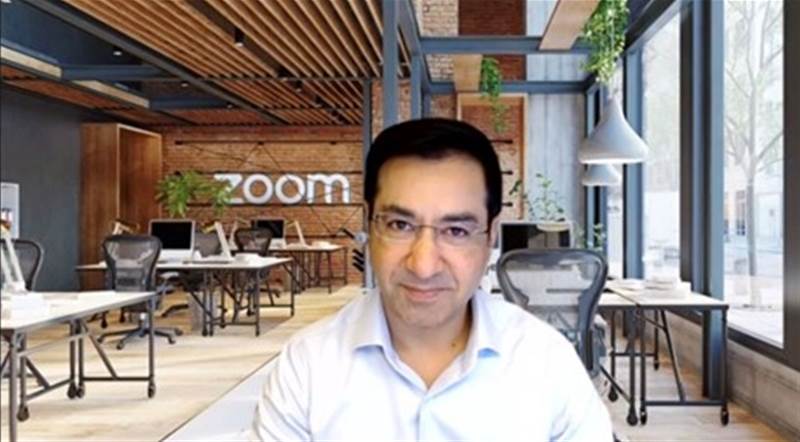Video conferencing provider Zoom has seen explosive growth during the pandemic and 2021 continues to have a strong year with revenues expected to surpass $4 billion.
The company also continues to evolve to serve larger and more diverse audiences, improving security and interoperability, and offering users better engagement, a more connected user experience and more inclusive experiences.
With hybrid and virtual poised to become a permanent fixture in the future of work. iTNews Asia takes the opportunity to speak with Ricky Kapur, Head of APAC, Zoom to find out more about how he views the changing customer needs, the longer-term outlook for Zoom in the APAC region and what we can do about ‘Zoom fatigue’.
iTNews Asia: What has Zoom learnt from customers the past two years, and how has that shaped what you’re doing now in the industry?
The last two years have seen a massive shift in how people consume video in their everyday business.
For Zoom, we’re seeing significant growth trends coming from three areas. First is the embedding of video into industries by frontline workers. The banker in a financial institution that is using Zoom to connect with his customer and completing the banking process – be it a personal or car loan or a SME bank loan. These workers are sharing documents and integrating E- documents into the signatures all through video and Zoom.
It’s the same in healthcare, where virtual consultations are very real now, or in education with online live lessons and tuition. In every business process, they’re looking at how they can embed video and connect with their customers or stakeholders.
The second big shift that is happening – from a customer adoption perspective – is that we’ve opened our Zoom SDK. Developers who are working for new digital companies, or for digital natives, or brick and mortar companies, are all embedding Zoom into their platforms.
The third trend we’ve seen is that Zoom is moving from being a killer app for video into an end-to-end platform.
iTNews Asia: Do you see this period (the last two years) as a time and an inflection point (in history) where collaboration for enterprises can now be led by video?
You no longer need to drive 20 kilometres just to view a product. Most companies can give you the ability to do that. Being able to connect before you go to a store, or an online property, or for a government to think about how it can provide certain services. While not every product will be bought over video, video has very much become part of the purchase or business cycle. That's the way we see things playing out in many other industries.
This virtual world is enabling people to reimagine things. A lot of businesses can now redesign their own premises with a hub and spoke model. They’re changing their business model to capture more time with their customers and stakeholders.
A bank was telling me they see a lot of people going online but they can't shut down all their branches. (In a hybrid world), there’s an opportunity now for the bank to build branches in smaller, separate locations and provide employment. These branches can be places where people can come and congregate and still go to work because they're secure.
iTNews Asia: With more competition coming in, the space you’re in is getting crowded. Is there's a need for Zoom to think differently to stay ahead?
We do have companies coming into the space. We respect them as they are innovative organisations providing a number of functionalities.
Zoom was built on a video architecture. The reasons people use Zoom are because of our rich features and the reliability and scalability of our architecture. That's our competitive advantage. As a company, our culture has not been about the competition. The focus has always been on customers – to keep innovating and increasing their happiness.
Where we see the shift happening is that customers are saying that they want the right tool for the right use. Just like there's no such thing as one cloud when you've got multiple clouds, they’re not willing to compromise on a less capable platform.
This virtual world is enabling people to reimagine things. A lot of businesses can now redesign their own premises with a hub and spoke model. They’re changing their business model to capture more time with their customers and stakeholders.
-Ricky Kapur, Head of APAC, Zoom
iTNews Asia: Has your user adoption continued to grow this year, and what are some of the partners and customers who are working with you in the enterprise segment?
We're continuing to grow and seeing increased adoption across our platforms. Zoom phone, for example, has now reached 2 million users in under two years.
We’re also seeing growth across SMEs as well as the larger companies. We now have 2,507 customers contributing more than $100,000 in trailing 12 months revenue, up about 94% from the same quarter last fiscal year. In the last quarter (Q3), we reached 512,100 customers with more than 10 employees, 18% higher from the same quarter last fiscal year
We're not standing still. Zoom recently launched a product called Zoom Video Engagement Centre that extends a traditional contact centre capability into video – anyone can now come into a virtual kiosk, or anywhere, and they can get to talk to a specialist to solve their problem.
Among enterprises, we’re also seeing a growing development ecosystem where customers are using our SDKs and embedding Zoom on their platforms. In this APAC region, Malaysia's Maybank and education provider MC Plus (serving more than 15,000 students), Australia National Bank (more than 4,000 users using Zoom), Australian retailers Cue and Brauz, India's Mindhouse, a health wellness provider, as well as our partners such as Indonesia carrier Telkomsel and Vietnam social network Gapo for Work, are all integrating Zoom into their platforms.
For instance, Gapo for Work has integrated Zoom into their working and communication platform for businesses, doing things such as setting up meetings and conducting employee reviews. Despite the pandemic, MC Plus was able to continue teaching by using Zoom to provide live tuition and reach 15,000 children. They’re playing a key role in bringing digital inclusion to communities in Malaysia.
iTNews Asia: Has the consumer and SME audience reached a peak for Zoom? Where will your focus be?
There’s a lot of growth with our APAC SMEs and they will continue to be important. However, we’re now seeing an increasing uptake in the larger customers. We’re putting much more emphasis on them that we had in the past. Most of the larger companies are saying they want their users with the right tool for the right use case. For many, the question is “How can they build new digital platforms that have video embedded in?”
We’re growing our organisation in APAC, both internally, in our go-to-market teams and our partner ecosystem, to capture that opportunity. We’re focusing on developers and digital mediums that are embedding Zoom into their platforms. We're also bringing in new distributors in Southeast Asia and Australia and appointing new carrier partners that can run their managed services on our platform.
Zoom is also working with governments across the region. For example, our partnership with the Economic Development Board in Singapore allows us to scale in a different way. We’ve also set up an R&D centre here in Singapore and growing our data centre footprint.

iTNews Asia: An ongoing concern about remote working has been the issue of ‘Zoom fatigue’. There are people and employees who are feeling overworked and suffering mental health issues. Is this something that Zoom is looking at?
We need to understand that there’s a lot value that's come out of these platforms. But we also know that excessive use can create fatigue, in some cases, mental health issues. Some people have adapted well, and some unfortunately have not.
At Zoom, we’re trying to do different things in the technology to make it more fun to use. We’ve created Zoom apps, many which are quizzes and even party games in business settings. We’re creating a number of things around reactions and emojis. They are human-centric and aimed to help a person relax.
We’re thinking a lot on how we can best use technology inside Zoom to make it more inclusive, whether that's through gamification or looking into mental wellness.
It's important that we remember to take a break. On a personal level, I take a lot of breaks in my diary. I set aside half an hour before meetings just to get my thoughts together. And people need to know that it’s also okay to have the video off. You can’t have the video on all the time.
iTNews Asia: One of the challenges with video conferencing has been the lack of the human or personal touch. For example, we’re seeing companies fire their staff over Zoom. Working hybrid and remote may make it difficult for employers to keep their staff motivated.
There are many efficiencies of being remote but that does not overlook the importance of the human connection. I believe every company must be true to their culture. Some companies want all their employees to come back to work. I'm not sure that's the answer either, because that's not inclusive.
A culture of inclusion says you must give people a chance to work in the best way possible for them.
iTNews Asia: How do you see the next one or two years panning out for the industry? How will Zoom be engaging customers?
As companies build their new digital platform, they need to think about how they can make it easy for their stakeholders to connect with. It’s not just customers but suppliers as partners, it's the entire value chain and how they can connect seamlessly.
It's going to be about embedding of video capability into an industry application where you can run an entire workflow. Those companies who can offer those capabilities will do better and will capture a higher market share in the next 12 months, whether that's digital healthcare or banking or elsewhere. That's where the future is headed in terms of technology and where the growth and opportunity are for us ahead.
Zoom has an incredible role to play in creating the next journey with the hybrid world. We know we won't be the only ones doing it, we will co-exist with others, but we will bring own flavour to the co-existence like we’ve had for the last two years.










